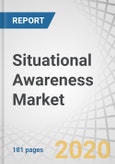Rising demand for situational awareness solutions in aviation and military across the globe to drive the growth of the situational awareness market
The situational awareness market is projected to grow from USD 17.2 billion in 2020 to USD 21.8 billion by 2025, recording a CAGR of 4.9% between 2020 and 2025. Increasing demand for situational awareness solutions in aviation and military, use of mobility solutions transforming military tactical operations, and growing importance of situational awareness in cybersecurity to provide significant situational awareness are the major factors driving the growth of the situational awareness market. However, errors in situational awareness systems act as a restraint for the market growth.
Based on components, sensors to be the fastest-growing segment between 2020 and 2025.
Sensors are used to collect real-time information for rapid target coordination, improved situational awareness, and increased mission execution. With the increase in demand for situational awareness for real-time data collection, the adoption of different kinds of detection and monitoring processes has increased. With the rising adoption of sensors in various applications such as smart infrastructure management, security and surveillance, logistics, and crisis management would further drive the market.
Sensors expected to be the largest segment in the situational awareness market during the forecast period
Sensors hold the largest share in the situational awareness market, by component as they are widely used in a number of products such as fire and flood alarm systems, access control solutions, command & control systems, among others. With the large adoption in these products and their significant use in industries such as military & defense, aviation, and homeland security is expected to drive the market for sensors.
APAC to record the highest growth rate in the situational awareness market during the forecast period
By region, the APAC situational awareness market is projected to witness the highest growth rate during the forecast period due to the increasing demand for situational awareness solutions in security and surveillance. Significant investments of the governments in aerospace, defense, and military in countries such as China and India would further boost the market during the forecast period.
In-depth interviews have been conducted with chief executive officers (CEOs), marketing directors, other innovation and technology directors, and executives from various key organizations operating in the situational awareness marketplace.
- By Company Type: Tier 1 - 52%, Tier 2 - 25%, and Tier 3 - 23%
- By Designation: C-Level Executives -55%, Directors – 27, and Managers - 18%
- By Region: North America - 40%, Europe - 20%, APAC - 28%, and RoW - 12%
General Electric (US), Lockheed Martin (US), Honeywell (US), DENSO (Japan), BAE Systems (UK), UTC (US), Microsoft (US), Barco (Belgium), AMD (US), L3Harris Technologies (US), General Dynamics (US), Xilinx (US), Qualcomm (US), Robert Bosch (Germany), Pleora Technologies (Canada), Nexvision (France), Bertin Instruments (France), Axis Communications (Sweden), Johnson Controls (Ireland), Boeing (US), Airbus (France), and Sensara (US) are some of the major players in the situational awareness market.
The study includes an in-depth competitive analysis of these key players in the situational awareness market, with their company profiles, recent developments, and key market strategies.
Research Coverage:
The report defines, describes, and forecasts the situational awareness market based on component, product, industry, application, and geography. It provides detailed information regarding factors such as drivers, restraints, opportunities, and challenges influencing the growth of the situational awareness market. It also analyzes product launches, acquisitions, expansions, contract, and partnerships carried out by the key players to grow in the market.
Key Benefits of Buying the Report:
This report will help market leaders/new entrants in this industry with information on the closest approximations of the revenue numbers for the overall situational awareness market and the subsegments. The report will help stakeholders understand the competitive landscape and gain more insights to better position their businesses and plan suitable go-to-market strategies. The report will also help stakeholders to understand the pulse of the market and provide them with information on key market drivers, restraints, challenges, and opportunities.
Table of Contents
Companies Mentioned
- AMD
- BAE Systems
- Barco
- Denso
- Harris Corp.
- Honeywell
- Lockheed Martin
- Microsoft
- Qualcomm
- Rockwell Collins
- Xilinx








